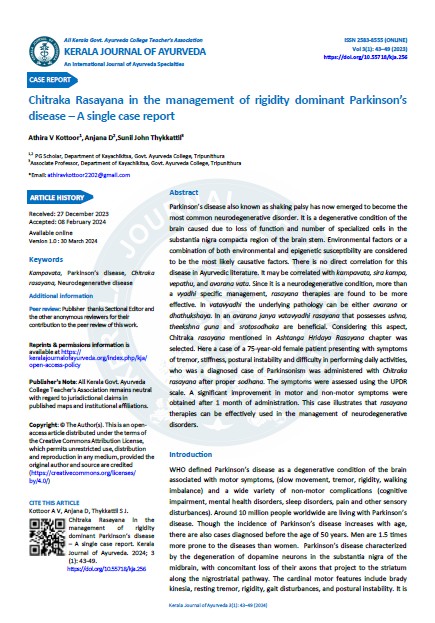Chitraka Rasayana in the management of rigidity dominant Parkinson’s disease –A single case report
DOI:
https://doi.org/10.55718/kja.256Keywords:
Kampavata, Parkinson’s disease, Chitraka rasayana, Neurodegenerative diseaseAbstract
Parkinson’s disease also known as shaking palsy has now emerged to become the most common neurodegenerative disorder. It is a degenerative condition of the brain caused due to loss of function and number of specialized cells in the substantia nigra compacta region of the brain stem. Environmental factors or a combination of both environmental and epigenetic susceptibility are considered to be the most likely causative factors. There is no direct correlation for this disease in Ayurvedic literature. It may be correlated with kampavata, sira kampa, vepathu, and avarana vata. Since it is a neurodegenerative condition, more than a vyadhi specific management, rasayana therapies are found to be more effective. In vatavyadhi the underlying pathology can be either avarana or dhathukshaya. In an avarana janya vatavyadhi rasayana that possesses ushna, theekshna guna and srotosodhaka are beneficial. Considering this aspect, Chitraka rasayana mentioned in Ashtanga Hridaya Rasayana chapter was selected. Here a case of a 75-year-old female patient presenting with symptoms of tremor, stiffness, postural instability and difficulty in performing daily activities, who was a diagnosed case of Parkinsonism was administered with Chitraka rasayana after proper sodhana therapies. The symptoms were assessed using the UPDR scale. A significant improvement in motor and non-motor symptoms were obtained after 1 month of administration. This case illustrates that rasayana therapies can be effectively used in the management of neurodegenerative disorders.
References
Shastri R.Charak Samhita, Vidyotini hindi commentary part I, Sutrasthana chapter20/11, reprinted edition, Pub: Bharathi academy, Varanasi, 2001;p-399.
Basavarajeeyam, Prof. MS Krishnamoorthy, etiology – symptomatology and treatment of vatika disorders , Chaukhamba Orientalia, first edition, 2014; 149
Charaka Samhita of Agnivesa- English commentary by PV Sharma, Part 2 Chaukhamba Orientalia, Varanasi, Reprint edition, 2005
Ayurveda pharmacopeia of India, first part, first volume, page 39
Madanapala nigantu, Dr J L N Shastri, first edition, Varanasi, Chaukambha bharatheeya academy; 105
Sarangadhara acharya.Translated by Srikanta moorthy, Sarangadhara Samhita, Madyama khanta, sneha kalpadyaya, Reprint- 2009. Sloka number 111-112; 126
Vagbhata. Ashtanga hrdaya with commentary Sarvanga Sundari, Ayurveda rasayana, Ed 8, Edr. Bhishakacharya Harishastry, Chaoukhamba Orientalia, Varanasi, 1998; 276





